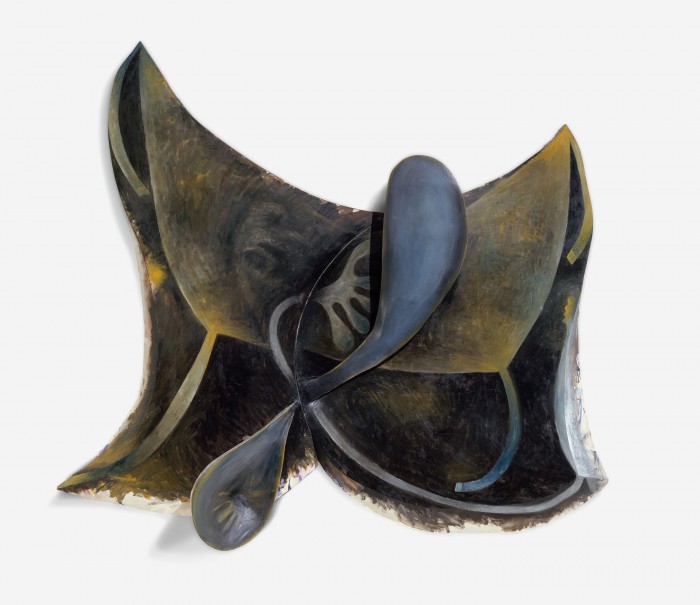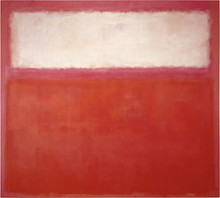Elizabeth Murray
Chain Gang 1985-1986

© 2014 The Murray-Holman Family Trust / Artists Rights Society (ARS), New York. Reproduction, including downloading of ARS member works is prohibited by copyright laws and international conventions without the express written permission of Artists Rights Society (ARS), New York.
Audio Description (02:19)
Full Audio Transcript (Expand)
Chain Gang
Elizabeth Murray’s Chain Gang is a dark black and tan painting of an abstracted table and two large spoons on four meticulously warped canvases. The two larger canvases overlap into roughly a bowtie shape. The two smaller canvases are the spoons. It is nine and a half feet high by ten and a half feet wide and the layered and warped sections give it a depth of sixteen inches.
The top edge dips in a wide arc, the left edge has a slight “S” curve and the right edge mirrors the left with a slight reverse “S” curve. The top corners give the impression of horns reaching up. The bottom edge is two sagging curves that meet in the center at a peak, the right curve overlaps the left and continues past the peak to curl around past the center to become the top edge.
On these two canvases is a cartoonish curved table with noodle legs. The simple drawing defies perspective making it unclear if the view is looking down on or up at the table. The top of the table shares the curved top edge of the canvas. The sides of the table arc inward leaving just enough space on the canvas for the short thin top legs that bow out. The thin bottom legs are longer and both curve towards the left. The table’s bottom edge is comparatively straight though the line shifts a few inches at the canvas overlap. The table’s surface is light tan heavily tarnished with soot-like black paint but also has highlights of saffron yellow at the corners. The negative space behind the table is much darker black applied with scratchy brush strokes.
The third and fourth canvases are two large teardrop shaped spoons, cool-gray like worn metal, their necks protruding from the canvas seam right above the bottom center peak. The lower spoon is about three feet long, reaches toward the bottom left, and faces out.
The bigger spoon is about five feet long, reaches towards the top right, curves up, and faces away. Both spoons reach beyond the bowtie canvases and also pull away so they cast a shadow on the canvas and wall behind it.
Behind the spoons but on top of the table, a long thin light gray object curves from the bottom right corner up around the center and fans to the right into five fat fingers like a gecko’s hand.
At the bottom of the painting, the paint application abruptly thins out into frantic brush strokes that leave bare beige canvas along the edge.
Chain Gang is a distinctive “oil on four canvases.” It complicates the notion of the single canvas with the spread of its bat-like wings and ballooning lungs. In many of her works, including this one, Murray challenged the rectangular convention of the canvas with new edges, shapes, and lines. Chain Gang takes its title from the 1960 Sam Cooke song. The cartoonish undulation of Chain Gang—Murray grew up drawing cartoons and hoping to be an illustrator—matches the up-tempo melody of Cooke’s song. The title of the piece, however, references imprisonment and forced labor, and the tar-colored organic forms convey the seriousness and darkness of Murray’s subject.
Redefining Feminism in Modern Art
Born in the Midwest and coming of age at a time when artists were deserting Abstract Expressionism, Murray is known for her distinctively shaped canvases. She started her education in hopes of becoming a commercial illustrator, having been influenced and inspired by comics. Here, the large-scale canvases ripple, fold over themselves, and even fracture, imperfectly interlocking into one—almost like the panels of an abstract comic strip that interacts with the viewer through its shape.
The domestic symbolism of Chain Gang, its cups, chairs, spoons, and tables, represents a re-exploration of everyday objects through abstraction and a critical engagement with the history of Western still-life painting. This symbolism has largely been attributed to Murray’s personal life, as she kept practicing her art while raising children. Yet motherhood informed, not inhibited, her art: she often collaborated with her daughters for her paintings, teaching and learning at the same time. Through both her subject matter and her process of making, Murray’s art urges us to reconsider our passive and gendered associations with domestic symbols, and the assumptions they perpetuate about women and artists.
—Irmak Ersoz ‘24





